愛媛大学 理工学研究科
Research Projects
Desaturation by air injection as liquefaction countermeasure
1 Development of innovative liquefaction countermeasure method
2 Liquefaction resistance of unsaturated sand
3 Verification of effectiveness as liquefaction countermeasure
3.1 Embankment
3.2 Residential house
3.3 Quay wall
4 In-situ air injection
5 Long term behavior of air in ground
5.1 Field evidence
5.2 Numerical simulation
6 Related publications
Development of innovative liquefaction countermeasure technique
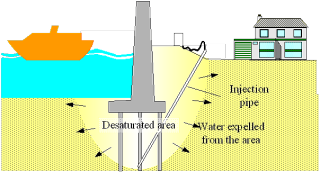 Along Japanese coast of Pacific ocean, huge earthquakes have repeatedly
occurred and are expected to recur in the near future. Extremely high Tsunami
of several to ten meters is expected. Dikes protecting coastline in areas
and roads for emergency traffics are often founded by liquefiable loose
sand. Those structures, among others, are highly vulnerable for liquefaction
indecent damage and remedial countermeasure against liquefaction is apparently
needed, however, most local governments almost give up for doing any treatment
for the structures because of budget squeeze and of the ground improvement
being very expensive. Liquefaction countermeasure techniques that can be
applied for existing structures are, in particular, costly, indicating
strong needs to develop inexpensive liquefaction countermeasure techniques.
The desaturation by air injection is the possible one. This method is just
to insert a pipe to liquefiable soils and exhaust air from the tip, as
schematically depicted in the figure. The Geotechnical Research Group of
Ehime University have extensively conducted research to develop inexpensive
countermeasure technique which is one order of cost lower than existing
techniques.
Along Japanese coast of Pacific ocean, huge earthquakes have repeatedly
occurred and are expected to recur in the near future. Extremely high Tsunami
of several to ten meters is expected. Dikes protecting coastline in areas
and roads for emergency traffics are often founded by liquefiable loose
sand. Those structures, among others, are highly vulnerable for liquefaction
indecent damage and remedial countermeasure against liquefaction is apparently
needed, however, most local governments almost give up for doing any treatment
for the structures because of budget squeeze and of the ground improvement
being very expensive. Liquefaction countermeasure techniques that can be
applied for existing structures are, in particular, costly, indicating
strong needs to develop inexpensive liquefaction countermeasure techniques.
The desaturation by air injection is the possible one. This method is just
to insert a pipe to liquefiable soils and exhaust air from the tip, as
schematically depicted in the figure. The Geotechnical Research Group of
Ehime University have extensively conducted research to develop inexpensive
countermeasure technique which is one order of cost lower than existing
techniques.
Liquefaction resistance of unsaturated sand
Okamura & Soga (2006)
It has been recognized that the soil resistance to liquefaction increases significantly as degree of saturation decreases. However, the effect of the degree of saturation reported in the literature varies widely between researchers. In our study, influential factors of the liquefaction resistance of partially saturated sand are derived from theoretical consideration and effects of the factors are examined through a series of triaxial tests.
Existence of air in the pore of soil is considered to enhance the liquefaction resistance of the soil in such a way that air in the pore plays a role of absorbing generated excess pore pressures by reducing its volume. The Bulk modulus of the pore fluid changes significantly by the presence of air bubbles. The bulk modulus and change in volume of the pore fluid, that is air water mixture, should be the factors dominating this mechanism.
Introducing Boyle’s law and assuming soil grains to be incompressible, we obtain the volumetric strain of the soil mass as
 (*1)
(*1)
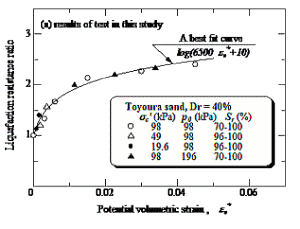 It was confirmed that the degree of saturation has a significant effect
on the liquefaction resistance. It also appeared that the liquefaction
resistance also depends on the initial confining pressure and the initial
pore pressure; the higher the confining pressure and the lower the initial
pore pressure, the higher the liquefaction resistance of partially saturated
sand soil. A unique relationship between liquefaction resistance ratios
and the potential volumetric strain was found, which enable to estimate
the liquefaction resistance of partially saturated (*1).
It was confirmed that the degree of saturation has a significant effect
on the liquefaction resistance. It also appeared that the liquefaction
resistance also depends on the initial confining pressure and the initial
pore pressure; the higher the confining pressure and the lower the initial
pore pressure, the higher the liquefaction resistance of partially saturated
sand soil. A unique relationship between liquefaction resistance ratios
and the potential volumetric strain was found, which enable to estimate
the liquefaction resistance of partially saturated (*1).
(*1)Kazama et al., and Unnno et al. conducted undrained cyclic triaxial tests on unsaturated sands with precise measurement of overall volume of specimen during shearing. Using the test results, we confirmed that the volumetric strain derived from the equation agreed quite well with those observed in the triaxial tests.
Okamura & Noguchi (2010)
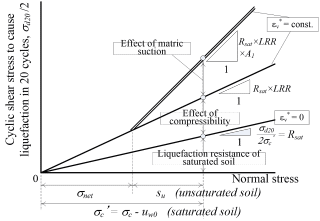 The matric suction is a unique characteristic of unsaturated soil, which
increases the effective stress and thus the strength of the soil mass.
The matric suction is a unique characteristic of unsaturated soil, which
increases the effective stress and thus the strength of the soil mass.
In our study two series of cyclic triaxial tests on a non-plastic silt
were carried out to look into both mechanisms on the liquefaction resistance
of the silt. In the first series, the top cap with an accumulator tank
was used to study the effect of compressibility of pore fluid on the liquefaction
resistance. The empirical relationship derived by Okamura and Soga is found
to be valid even for the silt provided that the matric suction is negligible.
While in the second test series an ordinary cap was used. The liquefaction
resistance 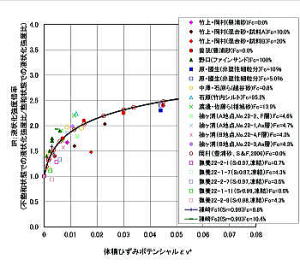 increases linearly with the matric suction, with the increasing ratio being
higher than that for the net stress. A unique linear relationship is found
between the normalized liquefaction resistance and the matric suction.
Results are summarized in the form which can be easily applied to evaluate
the liquefaction resistance of a partially saturated soil.
increases linearly with the matric suction, with the increasing ratio being
higher than that for the net stress. A unique linear relationship is found
between the normalized liquefaction resistance and the matric suction.
Results are summarized in the form which can be easily applied to evaluate
the liquefaction resistance of a partially saturated soil.
Triaxial test were conducted for many sands with variety of fine contents. It has confirmed that the same relationship holds true for all the sands tested except for sand of IP>0.
Verification of effectiveness as liquefaction countermeasure
Embankment
Highways play a key role of providing not only usual but emergency traffic
transportation in case of earthquake. In Shikoku area, Japan, a total of
10km of highway embankment is expected to be severely damaged due to liquefaction
of thick foundation sand by an earthquake. Application of liquefaction
countermeasure techniques to foundation soil below existing embankments
was considered, however, the estimated cost was far beyond the budget.
A challenge that geotechnical engineers have been facing is the remedial countermeasure works for enormous length of existing embankments which are susceptible to liquefaction induced damage. In this paper, a newly developed liquefaction countermeasure technique of dramatically low cost, the desaturation method by air injection, is introduced. This technic attracts considerable attention in recent years as an innovative technique which can be applicable to soil just beneath existing structures. Effects of the technique on a seismic performance of embankments are examined through a series of centrifuge tests.
Three models were prepared as shown in Figure1; one is saturated foundation soil model (model 1) and the others are desaturated foundation soil model by air injection (models 2 and 3). The model consisted of a 2m high well compacted prototype embankment resting on a 5.4m deep loose liquefiable sand bed. The models were shaken at 40g with input acceleration amplitude of 2.8 m/s2.

Distribution of the maximum excess pore pressure (EPP) is depicted in Fig.
5. The EPP for the benchmark model 1 at any location is close to the initial
effective overburden stresses, σv’. On the other hand, EPP in observed
in the desaturated zone is significantly low, clearly indicating the effectiveness
of desaturation on the excess pore pressures.
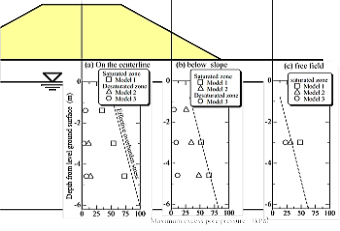 Settlement of the embankment crest is depicted in Figure 3. The crest settlements for model 2 and 3 were less than one-seventh of that for model 1. It can be concluded that countermeasure to soil beneath embankment with the desaturation technique has the significant effect to reduce embankment settlement. Also shown in the figure is the crest settlement obtained from numerical residual deformation analysis, ALID (Yasuda et al., 1999). The simulated residual deformation agrees well with that observed in the tests.
Settlement of the embankment crest is depicted in Figure 3. The crest settlements for model 2 and 3 were less than one-seventh of that for model 1. It can be concluded that countermeasure to soil beneath embankment with the desaturation technique has the significant effect to reduce embankment settlement. Also shown in the figure is the crest settlement obtained from numerical residual deformation analysis, ALID (Yasuda et al., 1999). The simulated residual deformation agrees well with that observed in the tests.
Maximum excess pore pressure distribution
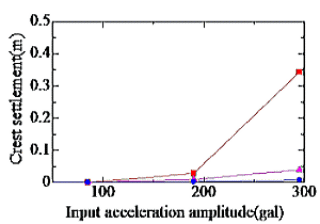

Comparison of crest settlement of embankment
Residential House
Four dynamic centrifuge tests were conducted to study the performance of a newly developed countermeasure technique against soil liquefaction: desaturation by air injection. In the experiment, liquefiable foundation soils below lightweight structures were desaturated by the air injection technique and base shaking was imparted to the models to obtain a comprehensive set of response data.
 The time histories of the EPPRs (the ratios of excess pore pressure to
the initial effective overburden pressure at each location) indicate that
EPPRs at all locations in the saturated centrifuge models increased and
nearly reached unity in a few cycles, indicating that the soil liquefied.
While for the desaturated models, EPPR responses were quite different from
those for the saturated models. Observed EPPRs in the desaturated zone
(B1, B2, C1, and D1) increased at a lower rate and stayed significantly
smaller than unity throughout the shaking events. In the saturated zone,
EPPRs at C2 and D2 reached
The time histories of the EPPRs (the ratios of excess pore pressure to
the initial effective overburden pressure at each location) indicate that
EPPRs at all locations in the saturated centrifuge models increased and
nearly reached unity in a few cycles, indicating that the soil liquefied.
While for the desaturated models, EPPR responses were quite different from
those for the saturated models. Observed EPPRs in the desaturated zone
(B1, B2, C1, and D1) increased at a lower rate and stayed significantly
smaller than unity throughout the shaking events. In the saturated zone,
EPPRs at C2 and D2 reached 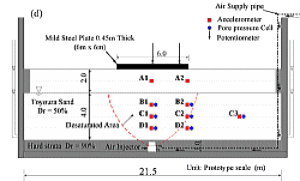 approximately unity during the latter shaking events, but were much lower
during the early events than those in the saturated model. This clearly
shows pore pressure interactions between saturated and desaturated zones
due to pore fluid migration during the shaking. EPPRs at C2 and D2 were
located close to the desaturated zone, and generated excess pore pressures
were absorbed by the desaturated zone. The EPPRs of C3, located relatively
far from the desaturated zone, were similar to those in the saturated models.
All features observed in the desaturated centrifuge models were relatively
accurately replicated by the numerical simulation. Simulated pore pressures
in the desaturated zone (B1, B2, C1, and D1) smoothly increased without
fluctuation, which was additionally apparent in the saturated zone. The
lower bulk modulus of pore fluid used for the desaturated zone in the simulation
is responsible for this phenomenon.
approximately unity during the latter shaking events, but were much lower
during the early events than those in the saturated model. This clearly
shows pore pressure interactions between saturated and desaturated zones
due to pore fluid migration during the shaking. EPPRs at C2 and D2 were
located close to the desaturated zone, and generated excess pore pressures
were absorbed by the desaturated zone. The EPPRs of C3, located relatively
far from the desaturated zone, were similar to those in the saturated models.
All features observed in the desaturated centrifuge models were relatively
accurately replicated by the numerical simulation. Simulated pore pressures
in the desaturated zone (B1, B2, C1, and D1) smoothly increased without
fluctuation, which was additionally apparent in the saturated zone. The
lower bulk modulus of pore fluid used for the desaturated zone in the simulation
is responsible for this phenomenon.

Numerical simulations of these experiments were conducted by using a two-phase (solid and fluid) fully coupled finite-element code, Coupled Analysis of Liquefaction (LIQCA-2D), to validate the numerical procedures. The mechanical properties of the soil in the saturated and desaturated zones in the models were exactly the same, with the exception of the degree of saturation. The simulation attempted to examine the desaturated models by changing the compressibility of the pore fluid, in which all input parameters for saturated and desaturated models were the same except for the bulk modulus, Kf. Numerical results were comparable with the test results in terms of excess pore pressures and settlement of structures for both saturated and desaturated models. This validates the numerical procedure and further assures the effectiveness of desaturation by the air injection technique as a liquefaction countermeasure.
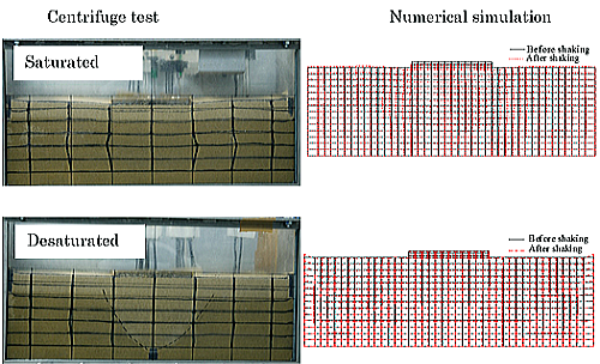
Quay wall
Under Construction
In-situ air injection
Okamura et al. (2011) has conducted in-situ tests where air was injected at a depth of 6m with the injection pressure of 45 kPa (the hydrostatic pressure 32 kPa + a net injection pressure 13 kPa) in Kochi prefecture, Shikoku. The zone of influence where soil was effectively desaturated extended around the injection point with a diameter of about 3.5m. The execution cost of the technique at this time was similar to those of such existing ground improvement technics as sand compaction piles. This is still far beyond allowable cost to remediate long road embankments which is susceptible to liquefaction damage.Since the material of this technique is air alone, installation cost of injection pipes occupied a larger part of execution cost, more than a half. Reduction of number of injection pipes will make this technique more cost effective. For soils directly below high embankments, because of higher effective overburden pressures, air injection with higher injection pressure can be executed without disturbing soils. It has reported that the higher the injection pressures, the wider the zone of influence around an injection pipe (Yasuhara et al., 2008).
 In this study, an attempt was made to increase the zone of influence and
reduce the number of injection pipes by applying a higher injection pressure,
of which anticipated results are a dramatic decrease in the execution cost
(*2).
In this study, an attempt was made to increase the zone of influence and
reduce the number of injection pipes by applying a higher injection pressure,
of which anticipated results are a dramatic decrease in the execution cost
(*2).The tests was conducted at a construction site of a highway embankment near the mouth of Imagiri River, Tokushima.
Soil profile and electrodes set at the site: the ground water table was 0.5m from the surface. Soil water retention characteristics were tested on disturbed samples with a pressure plate apparatus and the minimum pressure observed at the onset of drainage, recognized as an air entry value, was in a range between 1 and 10kPa. There were several thick clay seams at the depths 5m and between 9m and 12m. As these seams were expected to impede upward flow of injected air, injectors were set at several depths so that whole the sand layer can be desaturated. In order to monitor the evolution of desaturated zone, electrodes were installed at intervals of 2.5 m in plan and 0.5m in depth.

Air injection was conducted one by one from each air injector. Two injection from injectors at a depth 8.3m in the A-1 hole and 8.2 m in the S-1 hole are discussed hereafter. In the injection test, injection air pressure was increased gradually until injected air started flowing into soil. The pressure was found to be 80 kPa.
Vertical view of variations of the electric resistivity change observed during injection at 8.3m in A-1 hole indicates that the desaturated zone seems to have extended diagonally upwards from the injection point with time. At 7.5 hours after initiation of injection, the zone of influence at the depth of injection point extended about 5m and more than 9m at a shallower depth. More than 16 hours after halting the injection at A-1 hole, which was considered to be long enough to dissipate excess pore pressures, very similar injection test was conducted from S-1 hole. Although the zone of influence was somewhat narrower than the injection from A-1 hole, soils in the radius of 5m was effectively desaturated in 6.5 hours.
 The diameters of the zone of influence attained in the tests are more
than three times larger than that observed in the previous test at the
Kochi site (Okamura et al., 2011). This means that number of boring wholes
for air injector can be reduced less than one ninth, resulting in very
significant reduction in execution cost.
The diameters of the zone of influence attained in the tests are more
than three times larger than that observed in the previous test at the
Kochi site (Okamura et al., 2011). This means that number of boring wholes
for air injector can be reduced less than one ninth, resulting in very
significant reduction in execution cost.
Air injection at a certain location in a ground creates zone of influence
around  the injection point. During the air injection, simultaneous flow of water
and air occurs, and thus the effects of capillary pressures and the mutual
flow interaction between the two phases should be addressed in a computational
manner. In this study, a gas-liquid two-phase simulator TOUGH2 (Pruess
et al. 1999) that accounts for the above requisites was utilized to estimate
the extent of the zone of influence.
the injection point. During the air injection, simultaneous flow of water
and air occurs, and thus the effects of capillary pressures and the mutual
flow interaction between the two phases should be addressed in a computational
manner. In this study, a gas-liquid two-phase simulator TOUGH2 (Pruess
et al. 1999) that accounts for the above requisites was utilized to estimate
the extent of the zone of influence.
Predictions of the evolution in degree of saturation utilizing the ground
model and parameters constrained in the previous section indicates that
a desaturated bulb augments as the prediction proceeds both upward and
laterally, and upward evolution is impeded by the bottom of clay layer
at -3.1m. This is quite similar to that observed in the injection from
S-1 hole.
(*2)Flow of injected air through saturated soils will occur when the air
entry pressure at the injection point is exceeded. The injection pressure
needs to overcome the sum of hydrostatic pressure at the injection point,
Phyd, and capillary pressure arising from the presence of the soil (Marulanda
et al., 2000). The minimum injection pressure is given by
![]() , where Pave is air entry value of the soil. In addition, air injection
pressures must be lower than the in situ effective stress in order to avoid
unwanted soil cracking or fissuring at around injection point. For a granular
material with no tensile strength, the upper bound to the injection pressure
may be given by
, where Pave is air entry value of the soil. In addition, air injection
pressures must be lower than the in situ effective stress in order to avoid
unwanted soil cracking or fissuring at around injection point. For a granular
material with no tensile strength, the upper bound to the injection pressure
may be given by
![]() where σ'vertical and σ'horizontal denote effective vertical and horizontal
stress, respectively. This has been experimentally verified by Ogata and
Okamura (2006) that the injection pressure at which cracking started to
develop was approximately 0.8 times the vertical effective stress in addition
to the hydrostatic pressure.
where σ'vertical and σ'horizontal denote effective vertical and horizontal
stress, respectively. This has been experimentally verified by Ogata and
Okamura (2006) that the injection pressure at which cracking started to
develop was approximately 0.8 times the vertical effective stress in addition
to the hydrostatic pressure.
Long term behavior of air in ground
Field evidence
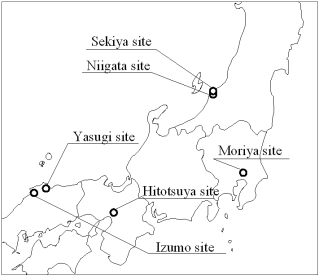 Sand compaction pile (SCP) has been extensively used to ameliorate liquefaction
resistance of loose sand deposits since 1970’s. Principle of this ground
improvement technique is densification of foundation soils by installing
compacted sand piles. Increases in soil density as well as lateral effective
stresses are believed to enhance liquefaction resistance of foundation
soils.
Sand compaction pile (SCP) has been extensively used to ameliorate liquefaction
resistance of loose sand deposits since 1970’s. Principle of this ground
improvement technique is densification of foundation soils by installing
compacted sand piles. Increases in soil density as well as lateral effective
stresses are believed to enhance liquefaction resistance of foundation
soils.
Soils below the ground water table are usually considered to be fully or
nearly saturated. A large number of observed primary wave velocities have
confirmed this. In recent years, however, inspections on high quality undisturbed
samples taken by the ground freezing method revealed that degree of saturation
of sand improved with SCP was peculiarly low. This fact 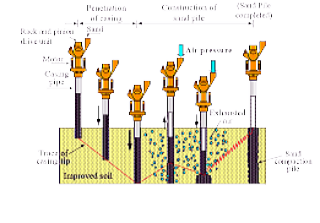 is consistent with the field observation that the primary wave velocity
of the sand improved with SCP was unusually low (Tokimatsu et al. 1990).
A large amount of air exhausted from casing pipe during the sand pile installation
is considered to have desaturated soils in the improved areas.
is consistent with the field observation that the primary wave velocity
of the sand improved with SCP was unusually low (Tokimatsu et al. 1990).
A large amount of air exhausted from casing pipe during the sand pile installation
is considered to have desaturated soils in the improved areas.
High quality undisturbed samples were obtained by the in-situ ground freezing
technique at six sites where foundation soil had been improved with SCP.
Inspection of samples as well as the primary wave velocity testing conducted
at a site confirmed that the improved ground contained air exhausted from
casing pipe during SCP installation. Degree of saturation (Sr) 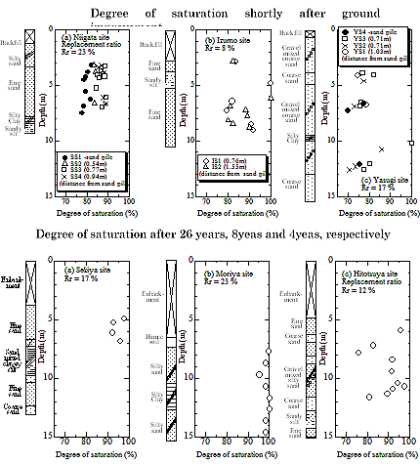 in the improved area was lower than 77 % for the sand piles and 91 % for
the improved soils in the sand layers, while Sr was approximately 100 %
for clayey and silty soils. Degree of saturation of improved soils depends
primary on the soil grain size but other factors including distance from
sand pile, depth and replacement ratio have little effect on Sr. A good
correlation was found between Sr and 5% diameter of the soil; the larger
5% diameter of soils (D5), the lower the degree of saturation. It appeared
that the variation of Sr and D5 for soils within a month after the ground
improvement work was quite similar in trend to that after more than several
years. Degree of saturation of soils after several years was noticeably,
but not significantly, higher than that shortly after ground improvement.
in the improved area was lower than 77 % for the sand piles and 91 % for
the improved soils in the sand layers, while Sr was approximately 100 %
for clayey and silty soils. Degree of saturation of improved soils depends
primary on the soil grain size but other factors including distance from
sand pile, depth and replacement ratio have little effect on Sr. A good
correlation was found between Sr and 5% diameter of the soil; the larger
5% diameter of soils (D5), the lower the degree of saturation. It appeared
that the variation of Sr and D5 for soils within a month after the ground
improvement work was quite similar in trend to that after more than several
years. Degree of saturation of soils after several years was noticeably,
but not significantly, higher than that shortly after ground improvement.
Numerical simulation
Under Construction
Related publications
Okamura, M. and Soga, Y. (2006). “Effects of pore fluid compressibility
on liquefaction resistance of partially saturated sand”. Soils and Foundations,
Vol. 46, No. 5, pp. 93-104.
Okamura, M., Takebayashi, M., Nishida, K., Fujii, N., Jinguji, M., Imasato, T., Yasuhara, H. and Nakagawa, E. (2011). “In-Situ Desaturation Test by Air Injection and Its Evaluation through Field Monitoring and Multiphase Flow Simulation”. J. of Geotechnical and Geoenvironmental Engineering, Vol. 137 , No. 7, pp. 643-652.
Narayan Marasini and Mitsu Okamura (2015): Air injection to mitigate liquefaction under light structures, Int. J. Physical Modelling in Geotechnics, Vol.15, Issue 3, pp.129-140.
Marasini N. P., Okamura M (2015): Liquefaction potential analysis and probable
remedial measure for existing structure in Kathmandu Valley, International
Journal of Landslide and Environment Vol.2, No.2&3, pp. 32-44.
Narayan,M. and Okamura, M. (2015): Numerical simulation of centrifuge tests to evaluate the performance of desaturation by air injection on liquefiable foundation soil of light structures Soils and Foundations, Vol.55, No.6, pp. 1388-1399.
Hideaki Yasuhara, Mitsu Okamura, Yoshinori Kochi (2008): Experiments and
Predictions of Soil Desaturation by Air-Injection Technique and the Implications
Mediated by Multiphase Flow Simulation, Soils and Foundations, Vol. 48,
No.6, pp. 791-804.
Mitsu Okamura, Masanori Ishihara and Keiichi Tamura (2006): Degree of Saturation and Liquefaction Resistances of Sand Improved with SCP, Journal of Geotechnical and Geoenvironmental Engineering, Proc. ASCE, Vol. 132 , No. 2, pp. 258-264
Mitsu Okamura, Masanori Ishihara and Takeshi Ohsita (2003): Liquefaction resistance of sand deposit improved with sand compaction piles, Soils and Foundations, Vol. 43, No. 5, pp.175-187.